One of the distinguishing elements of the Florida skyline is tropical palm trees. Florida is home to a variety of palm species that may be found across the state. Florida palm trees may be found on beaches, beside highways, and in parks. They are typically tall and attractive. Some tiny and dwarf palm trees suitable for residential garden environments may be found in Florida.
It’s important to choose the proper sort of palm tree for your location because of Florida’s many growing zones. Several cold-hardy Florida palm varieties can tolerate light frost. Other sun-loving palms, on the other hand, can only be found in southern Florida, which is hot and humid all year.
The most frequent palm trees found in Florida are described in this article. Florida palm trees can be identified using photographs and descriptions of the leaves, trunks, and growth habits.
Growing Zones in Florida
USDA growing zones 8-10 are used to divide Florida, with zone 11 being the Florida Keys. The temperature in the winter in zone 8a, which includes northern Florida, may drop as low as 15°F (-9°C).
As a result, to cultivate in the state’s northern section, you’ll need to locate cold-hardy Florida palms. Minimum temperatures in Miami range from 30°F (-1°C) to 40°F (4°C), in zone 10. Palms thrive in warm summers and can endure brief periods of chilly temperatures.
Palms for Growing in Florida
Palm trees grow well in Florida thanks to the state’s favorable conditions. The climate is hot and wet in the summer and cool and dry in the winter, which favors palms growing on sandy soil.
Winters in northern Florida may see temperatures below freezing, with the ground seeing some frost. Pindo palm, dwarf palmetto, Sabal palmetto, and needle palm are all examples of Florida native palms that are cold hardy and thrive in zones 8 through 11.
The southern section of Florida, near the Miami area, is also home to cold hardy palms. Nonetheless, only south Florida can support cold-sensitive native palms like the royal palm tree and silver palm.
Florida Palm Tree Facts
Florida is home to 12 palm tree species. Cabbage palms, needle palmss, royal palmss, and silver palmss are some of the most frequent native Florida palms. Several foreign palms, on the other hand, may be seen growing in various regions of Florida.
Palm trees are distinguished from other Arecaceae family members by their long, thick stems and crown of arching fronds (branches). Florida palms may grow to be over 100 feet (30 meters) tall. The smaller, dwarf native Florida palms may be as little as 20 feet (6 meters) tall for a palm tree.
Types of Palm Trees in Florida (With Pictures) – Identification Guide
Let’s take a closer look at some of the most common palm characteristics seen in Florida. You’ll find native Florida palm trees as well as popular palms from other countries in this list.
Dwarf Palmetto (Sabal minor)
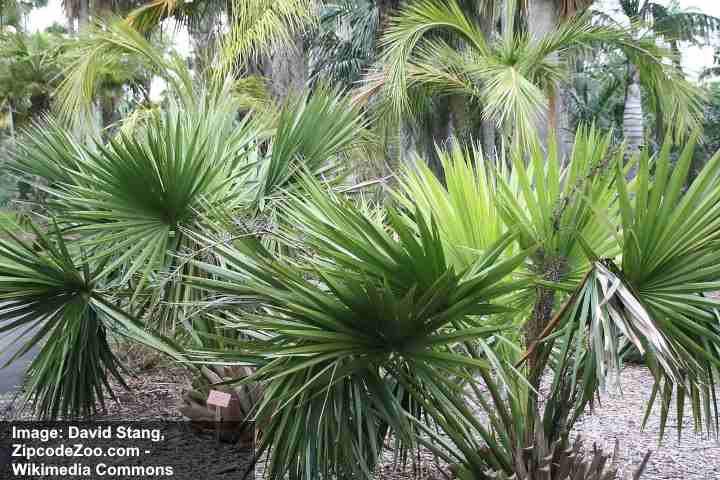
Dwarf palmetto palm has huge fan-shaped leaves, a small fat stem, and smooth branches that are cold hardy. This is a tiny palm species that seldom grows bigger than 3 ft. (1 m) tall, as its name suggests. The dwarf palmetto can withstand temperatures as low as 0°F (-18°C) since it is a cold-hardy Florida palm.
In zones 7 through 10, this dwarf palm is ideal for home gardens. The dwarf palmetto in the shape of a fan growing on a short, smooth trunk is identified by green fronds.
Needle Palm (Rhapidophyllum hystrix)
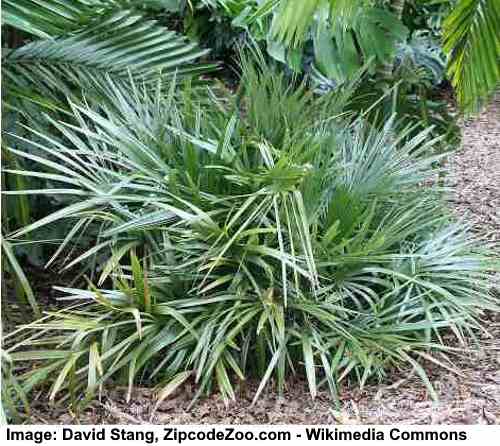
The needle palm, which is a Florida native palm, resembles a palm bush and grows like one. The thick trunk and fan-shaped fronds of this native Florida palm distinguish it from other palm species. One of the toughest palms in Florida is the needle palm, which is endemic to the state. It grows in zones 6 through 10, and can withstand temperatures of 5°F to -15°C.
The height of this small, hardy palm tree ranges from 3 to 4 feet (1.2 to 1.2 m). The short needle palm’s clumping growth of fan-like leaves, robust trunk, and rounded development are all characteristics that distinguish it from other palm trees.
Scrub Palmetto (Sabal etonia)

The scrub palmetto has fan leaves growing at the top of a solitary thin stem and is native to Florida. It is cold hardy. Only Florida contains this small palm tree. The tree’s stem may reach 6.6 feet (2 meters) in height, although it is commonly underground. Ground cover leaves of the spiky frond palm are ideal.
USDA zones 8a through 11 include a cold-hardy Florida palm tree that can endure temperatures as low as 10°F (-12°C). Scrub Palmetto Identification: Thin yellowish-green blades with a somewhat bent development growing in a fan shape are used to identify Florida palm trees.
Saw Palmetto (Serenoa repens)

The fan-like leaves, sharp spiky branches, and yellowish-white flowers of the little saw palmetto Florida palm make it ideal for tight locations. This is a 7 to 10 foot (2 to 3 m) tall plant that thrives in Florida and is rather hardy. Big dark red drupes make up the palm fruit. In zones 9a through 11, this Florida palm is cold tolerant to 20°F (6°C).
A twisted stem, big leaves with a fan-like look, and pointed branches are all characteristics of the Florida palm tree.
Sylvester Palm (Phoenix sylvestris)

The Sylvester palm, sometimes known as the silver date palm, is a coldhardy and sluggish growing tree that may be found all around Florida. The fat trunk of the medium-sized palm tree looks like a pineapple skin. The size of the palm varies from 13 feet to 15 feet. It has a 32-foot (10-meter) broad leafy crown that grows to 50 feet (15 meters). Drought-tolerant, sluggish-growing, and exceedingly cold-hardy are the characteristics of Sylvester palm trees.
The Sylvester palm is distinguished by sharp, hard, pointed leaves, a rough fibrous trunk, and a huge bushy palm crown. It grows in all stages of Florida from zone 8b to 11 Florida Palm Tree Identification.
Keys thatch palm (Leucothrinax morrisii)
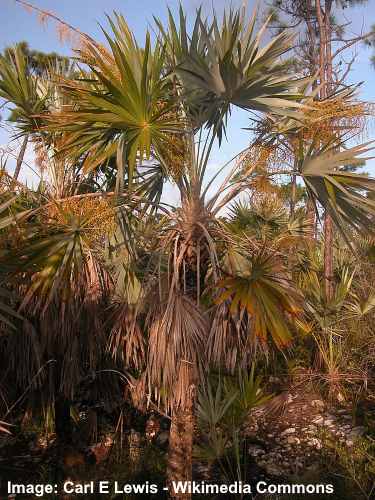
The key thatch palm (also known as brittle thatch palm) has fan-shaped (palmate) leaves and grows on a single long stem. It is native to the Florida Keys. Long, up to 2.5 ft (0.7 m) long, pale yellowish-green or blue-green leaves with thin leaflets This small Florida palm, which grows from 3 feet to 3 feet tall, thrives on diverse growing conditions. A tall (1 m) or towering palm tree that grows to be over 36 feet (11 m) high.
The key thatch palm, which thrives in zone 9b and is wind and frost tolerant, is cold-hardy to 30°F (-1°C). The keys thatch palm is distinguished by its large spiky leaves that grow on numerous branches, a fibrous stem, and tiny white fruits.
Florida Thatch Palm (Thrinax radiata)

The Florida thatch palm has a palmate crown of leaves and is cultivated in South Florida. These cold-sensitive palms suit garden landscapes or container growing and thrive in coastal environments. Southern palms can grow to be 20 feet (6 meters) tall if they are not pinched. Suitable for cultivation in south Florida, it grows in USDA zones 10 through 11.
The Florida thatch palm tree is a slender palm tree with between 10 and 20 green palmate leaves that creates a canopy.
Bismarck Palm (Bismarckia nobilis)
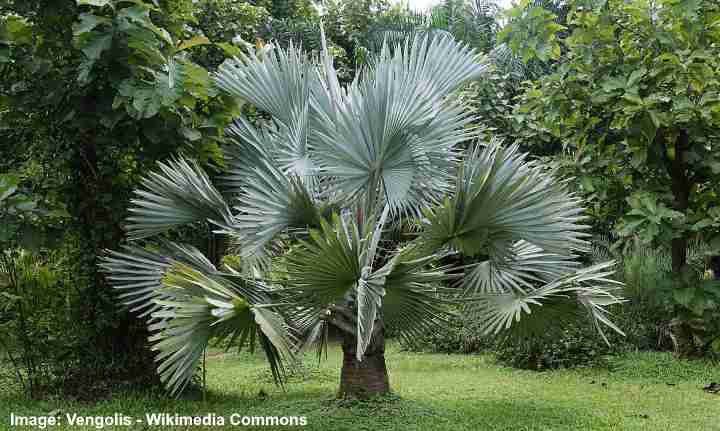
The Bismarck palm is a little tree with beautiful silver gray leaves that is cold sensitive. It isn’t native to Florida, but it’s one of the most popular palms in the south. The slender, fat, fibrous trunk and spectacular display of large silvery-grey fronds distinguish the magnificent palm. This is a 20-foot-tall (6 m) palm tree that grows in this manner. The rounded crown of the palm tree may be up to 22 feet (7 meters) broad, with palm leaves that may grow up to 10 feet (3 meters) broad.
Only in zone 11 in south Florida does this cold-sensitive plant grow. The Bismarck palm is distinguished by its huge silvery crown of palm leaves and fat, rough stem. Florida Palm Tree ID:
Florida Silver Palm (Coccothrinax argentata)

The slender, smooth trunk, dark blue-green leaves with a silver underside, and globose purple palm fruits are all features of the native Florida silver palm. This small indigenous Florida palm can grow to be up to 6.5 feet (2 meters) tall.
In southern Florida, from zone 10b through 11, the Florida silver palm is a little palm tree. The Florida silver palm tree is distinguished by having a single smooth upward-growing stem. Palmate compound silvery-gray leaves with a globular appearance are also worth noting.
Paurotis Palm (Acoelorrhaphe wrightii)

The Paurotis palm is a tiny to medium-sized Florida palm with fanning fronds. The Paurotis palm has a thin stem with fibrous growth. The paurotis palm has a sparse appearance with its thin trunk and fanning leaves. Zones 9 through 11 are home to this Florida palm tree.
Everglades palm, Madeira palm, and Cubas palm are all names for the same plant. The palm tree is small to moderately tall, growing between 16 and 23 feet (5 and 7 meters). Paurotis Palm Description: The light green fronds of the paurotis palm spread out, giving it a spiky appearance.
Alexander Palm Tree (Ptychosperma elegans)

The Alexander palm is a small to medium size palm tree that thrives in warm tropical conditions and is ideal for south Florida gardens landscapes. The stems of this palm are self-cleaning and have multi-stemmed species. The pinnately complex fronds emerge at the end of the lengthy straight stalk, growing to 8 feet (2.4 meters). The medium-sized Alexander palm tree grows to a height of 20 to 40 feet (6 to 12 meters) depending on the environment.
The palm is hardy to 40°F (4.5°C) and grows well in zone 11. Although not to be confused with the tall Sabal palmetto palm tree, the palm tree is also known by names like elegant palm, Solitaire palm, and cabbage palm. The Alexander palm tree has a smooth, slender gray stem that bulges at the base and is easy to identify. Pinnate leaves with an arching development should be sought after. The Alexander palm tree can also be identified by bunches of red palm fruits.
Buccaneer Palm (Pseudophoenix sargentii)
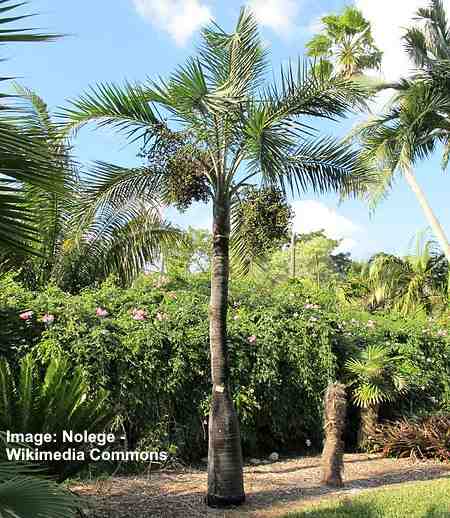
The buccaneer palm is a small, slow-growing tree that is sensitive to cold. The long arching fronds and swollen smooth trunk with ringed patterns identify the medium-sized Florida palm, which may grow up to 26 feet (8 meters) tall. The spreading out of this low-growing elegant palm’s long branches forms a flat fan pattern. Zones 10a through 11 are ideal for growing cold-sensitive palms.
You may also cultivate buccaneer palm in a pot and bring it indoors during the winter if you prefer the appearance. The buccaneer palm is recognized by its somewhat bulbous trunk with ring markings and lengthy branches that arch out to form a wide canopy.
Foxtail Palm (Wodyetia bifurcata)
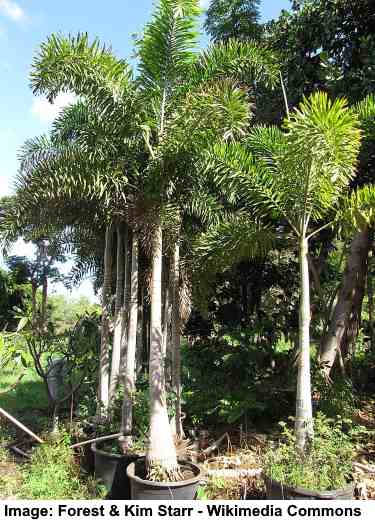
The foxtail palm is a popular palm species in Florida, and it grows as a medium-sized tree. The arching fronds that spread from the top of the silvery-white stem distinguish the medium-sized palm tree. The palm’s branch development, which resembles a fox’s tail, earned it the name. Foxtail palm trees, which are similar to huge royal palm trees, grow quickly.
The popular Florida palm thrives in zones 10b and 11, but only grows in the southern parts of the state. The 30-foot-tall medium-sized palm It stands at a height of 9 meters. Florida Foxtail Palm Description: The bushy arching fronds, branchless smooth columnar trunk, and ringed patterns on the white frond distinguish it from other palms.
Queen Palm (Syagrus romanzoffiana)

In zones 9 through 11, the Queen palm is a popular fast-growing decorative tree. The medium-sized palm tree grows to be around 50 feet (15 meters) tall. The palm’s crown has a bushy appearance because of the long pinnate leaves with hundreds of leaflets that are approximately 1.5 feet (50 cm) long.
Queen Palm Tree Characteristics: The solitary smooth stem, glossy bright green leaves, drooping canopy, and golden orange palm dates help to identify the queen palm.
Chinese Fan Palm (Livistona chinensis)
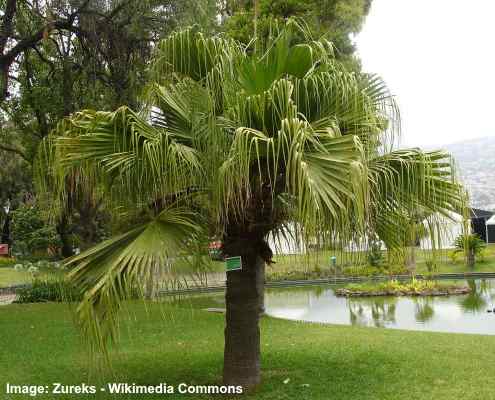
The Chinese fan palm is a lovely tall palm tree that thrives in Florida’s decorative gardens. It is a chilly hardy decorative tree. All throughout Florida, these hardy palms flourish. The drooping fan leaves, which give them a fountain-like appearance, are their distinguishing feature. Trunks reach 50 feet (15 meters) in height, with a spreading crown.
Fan palms from China can be found in zones 9 through 11 and are tolerant of temperatures down to 20°F (-12°C). The Chinese fan palm has fan-shaped leaves with an arching growth pattern that gives it a bushy, drooping crown and is identifiable by its fan-shaped leaves.
Canary Island Date Palm (Phoenix canariensis)
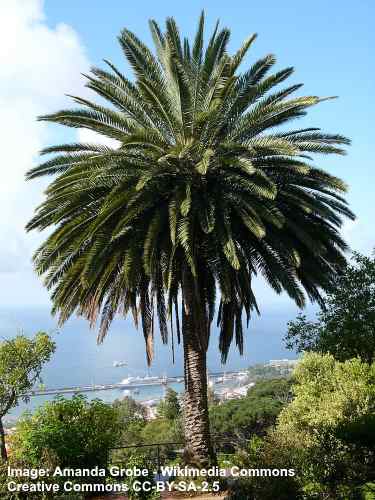
The Canary Island date palm is a popular sun-loving palm tree on the south coast, with a tall and cold hardy stem. The large palm grows to be 66 feet (20 meters) tall, making it unsuitable for most Florida residential garden landscapes. The crownshaft of the fat palm tree is bulging, and the trunk is rough and straight. A central point at the top of the tall trunk produces pinnate arching leaves. It’s cold hardy to 10°F (-12°C) and can be grown in zones 8a through 11.
The Canary Island date palm has a strong upright stem with a crown of hard, pointed leaves and clusters of palm fruits (bundles of orange-yellow dates) to distinguish it from other Florida palm trees.
Ribbon Fan Palm (Livistona decipiens)
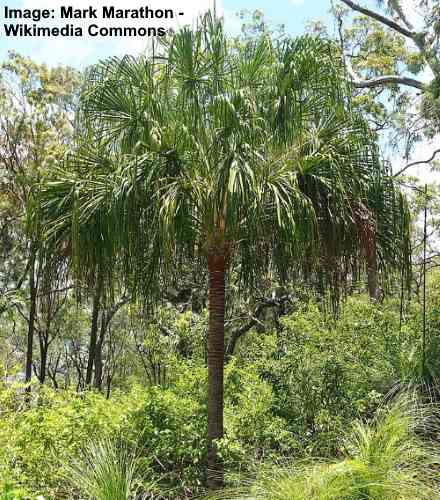
The ribbon fan palm is a sluggish growing tree that thrives in the southern and central parts of Florida. The solitary, upright straight stem with a smooth finish distinguishes the ribbon fan palm tree. The fan-shaped leaves that split into lengthy drooping ribbons give this palm its name. The ribbon fan palm grows at a steady pace, eventually reaching 60 feet (18 meters) in height.
USDA zones 9 through 11 are suitable for growing the ribbon fan plant. The graceful ribbon-like fronds that form an umbrella-shaped bushy palm crown are used to identify Florida palm trees.
Cabbage Palm (Sabal palmetto)

The cabbage palm (sabal palmetto) is Florida’s state tree, and it is a tall cold hardy palm. The fibrous trunk of the cabbage palm tree is bronze, with fan-shaped leaves and a rounded crown on top of a long single stem. The brown-colored dead palm leaves at the base of the crown are an identifying characteristic of this Florida palm.
In zones 8 through 11, the cabbage palmetto palm can grow up to 65 feet (20 meters). The ‘Floridian’ palm thrives in winter temperatures as low as 9°F (-12°C) thanks to its hot, humid summers. Florida Palm Tree Characteristics: Before becoming bronze and rough due to old leaves petioles, the trunk of a Florida palm tree is smooth and gray at its base.
Florida Royal Palm (Roystonea regia)

The royal palm tree can grow up to 66–98 feet (20–30 meters) tall in southern Florida. The thick, bulging smooth trunk of the tree, which is a pale-gray color, is used to identify it. The crownshaft, a smooth green portion of the stem, is another distinguishing characteristic. Pinnate palm leaves can grow up to 13 feet (4 meters) long.
Some of the tallest palm trees in southern Florida are royal palms, which are among the oldest. Palms are cold hardy at 26°F (-3°C) and grow in zones 10a through 11. They have a regal appearance. The green crownshaft near the arching leaves distinguishes the Florida royal palm from other palm trees. The trunk is also grayish in color, with rings on it, and is thick, fat, tall, and straight.
Coconut Palm (Cocos nucifera)

Coconut palms are a common species of palm tree in Florida, with stems that may stretch up to 100 feet (30 meters) tall in the tropical climate. The palm tree’s pinnate leaves create an arching crown by growing at the top. The fruit of the palm genus Cocos is, of course, coconuts rather than juicy dates, which is another distinguishing characteristic.
In zones 10a and 10b of Florida, these cold-sensitive palms thrive. Coconut palms have a smooth gray stem with a huge swelling at the base, which is used to identify them. The pinnate foliage may stretch up to 20 feet (6 meters) long.
King Palm / Bangalow Palm (Archontophoenix cunninghamiana)

The king palm tree is a popular palm in Florida’s humid subtropical climate because of its height and slender trunk. The single, upright, brownish-gray trunk of the fast-growing palm tree arches with Evergreen fronds. The palm is also known as the Bangalow palm because of its clusters of long dangling red fruits.
The monarch Palm grows to be around 20 feet (6 meters) tall and 10 feet (3 meters) broad. 15 to 20 palm fronds, up to 15 inches (4.5 meters) long, with approximately 100 to 150 leaflets on each stem make up the crown. The king palm has a clearly defined straight, slender grayish stem that is somewhat wider at the base. At the crown shaft, arching green fronds create a shower of foliage.
Red Latan Palm Tree (Latania lontaroides)

The red latan palm is a medium-sized tropical palm tree that thrives in southern Florida’s coastal areas. The light green fronds of the palm have a whitish sheen and are ridged in a fan shape. The spiky crown of the upward growing fronds makes it seem like a huge globe. Little yellow blossoms emerge in the spring, followed by brownish-green palm fruits.
USDA zones 10 through 12 are ideal for red latan palm trees. With a rounded crown up to 20 feet (6 meters) wide and growing in full sun, the huge palm may reach 30 to 40 feet (9–12 meters) tall. Each frond is 8 feet (2.4 meters) broad and made up of stiff leaflets on 5 foot (1.5 meter) stems.
The reddish frond stems and leaves of immature red latan palm trees are the source of the common name red latan. Florida palm tree identification: The red latan palm is an easy-to-spot palm in the state. Its silky, silvery leaves take on a scarlet tint as they mature and take on a green tint.
Fishtail Palm (Caryota mitis)

The fishtail palm is a multi-stemmed plant with bipinnate leaves that resemble a fish’s tail fin, and it is recognized by its multiple stems. With a 10-foot (3-meter) spread, the grouped stems reach up to 40 feet (12 meters) tall. The leaves of the fishtail palm are 10 feet (3 meters) long. In the spring, the clustering fishtail palm produces lovely creamy-white blooms that contrast nicely with the glossy feathery green leaves. The blooms turn dark red to purple poisonous fruits after they have bloomed.
The multi-stemmed fishtail palm is most often seen growing in woodland and hummocks in Florida. The easiest way to differentiate between Florida palm trees is by looking at their ruffled fronds. Each triangular leaflet, with serrated borders that resemble the end of a fish, is made of shiny green paper.
Montgomery Palm (Veitchia arecina)

The Montgomery palm is a gorgeous crown palm tree that grows in the Florida sun. With a crown of long, pinnate fronds that may grow up to 10 feet (3 meters) tall, each palm tree has a straight, upright grayish smooth trunk. The white crown-shaft is home to the arching fronds. Montgomery palms may reach a height of 80 feet (24 meters).
One of Florida’s 10 Great Palms is the Montgomery palm tree. The solitary palms, which have 3ft (1m) long stems and clusters of greenish-white flowers, bloom in the spring. The palm tree produces clusters of red palm fruits between 1″ and 2″ (2.5 cm) long after blooming.
The Montgomery palm has a thin, grayish long stem, a beautiful arching pinnate frond crown, pale green crown shaft, and red fruits that make it easy to identify.
Red Sealing Wax Palm / Lipstick Palm (Cyrtostachys renda)

Due to its vividly-colored, red crown-shafts, the red sealing wax palm is a little tree that adds personality to Florida gardens. The bright tropical palm has smooth red stems and dark green palmate leaves with stiff leaflets that grow upward. It is also known as the lipstick palm. Lipstick palms can grow to be up to 20 feet (6 meters) tall in gardens.
Multi-stemmed trees with thin trunks, red sealing wax palms are multi-stemmed trees. As the palm tree develops, the smooth stems turn scarlet and then green. The top of the palm, on the other hand, still bears the brilliant red crown-shaft. Before producing inedible oval black fruits, the lipstick palm blooms with small greenish flower stalks.
The red sealing wax palm tree has numerous stems, each with a distinctive scarlet-colored crown-shaft, making it simple to tell apart from other palm trees. The spiky crown is created by the upward growing stiff, slender leaves.
Arikury Palm (Syagrus schizophylla)

In Florida, the arikury palm is a petite tree that works well in small gardens. The ground-clumping palmate fronds develop into a tree-like plant, extending straight from the ground. The fronds are 4 to 6 feet (1.2 to 1.8 meters) long and have an arching and drooping appearance.
The lovely arikury palm has a 10-foot (3-meter) spread and grows to be up to 6 feet (1.8 meters) tall. The unique serrated petioles of this Florida palm are a distinguishing feature. The arikury palm, unlike other decorative palms in Florida, has no smooth crown-shaft. The arikury palm has 2 to 3 feet (0.6 to 1 m) flowering stalks with golden yellow blooms, 1-inch (2.5 cm) long yellow or orange fruits, and a shaggy appearance.
The arikury palm is readily recognized in the landscape because to its small height, short trunk made up of many branches, and long arching dark green palmate fronds.
European Fan Palm / Mediterranean Fan Palm (Chamaerops humilis)
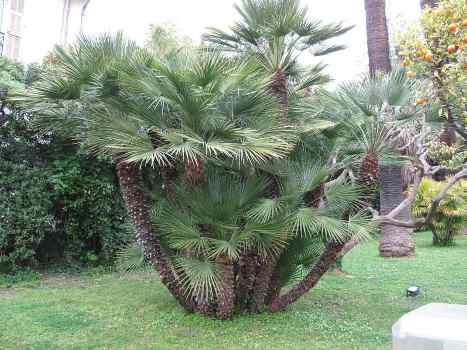
The European palm is a shrub-like palm tree that grows between 10 and 20 feet (3 and 6 meters) tall. It has few trunks and is suitable for many gardens in Florida. The thick, spiky trunk of the stumpy, short palm has fan-shaped silvery-green stiff, pointed leaves that may grow up to 5 feet (1.5 meters) long.
In Florida, the hardy multi-stemmed Mediterranean fan palm tree is popular for gardens. A lovely focal point or corner accent is created by the slow-growing palm. It is suited for tiny garden landscapes because of its jagged sturdy stem, fan-shaped palmate evergreen leaves, and compact growth.
The European fan palm has blue-green, or silver rounded fan-shaped fronds that cluster thick stems with jaggy spines and sharp needle-like spines on the petioles. Florida palm tree identification:
Pygmy Date Palm (Phoenix roebelenii)

The pygmy date palm Tree has a single shaggy trunk, gracefully arching frond crown, and black oval palm fruits. It is commonly used in Florida landscaping. The sharp spines at the petiole’s base of the bright green palmate leaves, which grow up to 4 feet (1.2 meters) long. On 1 ft. (30 cm) long stems, creamy-white blossoms and black fruits bloom.
The trunks of planted clumps tend to bend gently away from the plant’s center, creating a stunning display when viewed in clusters. In Florida, the pygmy date palm is a popular landscaping palm. In a garden landscape, three to five pygmy date palms are typically planted alongside the single-trunk palm tree. The date palm, on the other hand, looks great in a container and is stunning as a focal point in a landscape setting.
The pygmy date palm resembles a tiny Florida palm tree with a stubby short trunk, so it’s easy to identify. A bushy head of feathery palmate leaves with a height of 3 feet (1 meter) is unique to this palm.
African Oil Palm (Elaeis guineensis)

The African oil palm is a solitary-stemmed palm with pinnately compound leaves and clusters of crimson oil fruit fruits that are commonly utilized in oil manufacturing. An African oil palm with a spreading, arching palmate leaves grows to be over 66 feet (20 meters) tall in the landscape.
One of the world’s most oil-producing plants is African oil palms, which are primarily grown for their palm oil. The bunches of orangey-red palm fruits weigh 11 to 66 pounds (5 to 30 kg) and are harvested in bunches. The African oil palm’s vase shape, clusters of pale-yellow flowers, and a knobby trunk are all traits that distinguish it from the red palm fruits.
The African oil palm is distinguished by its gray trunk with triangular woody ridges, which distinguishes it from other Florida palms. The upward arching pinnate fronds and colorful fruits hanging in large clusters give the palm tree its lovely form.
Parlor Palms (Chamaedorea elegans)

A tiny low-maintenance tropical palm tree, the Parlor palm is ideal for small gardens. The Feng Shui considers it to be one of the lucky plants because of its clumping cane-like stems that grow from the ground. Dark green pinnate leaves 18 to 24 inches (45 to 60 cm) long with slender lance-shaped leaflets that grow alternately are the distinguishing characteristics of this palm. Golden yellow blooms appear on the palm, as well as tiny black fruits.
USDA zones 10 to 12 are ideal for the parlor palm. The leafy palm plant may reach a height of 7 feet (2.1 meters) in partial shade to full shade in a subtropical garden landscape. Little golden yellow ball-shaped blossoms emerge in the early spring, followed by black palm fruits.
Palm houseplants are also popular in parlors. The potted palm grows well in ordinary indoor settings. Any indoor space can be enhanced with the arching evergreen fronds. They also have the benefit of cleaning household air, which is an added bonus.
The parlor palm is a tropical plant with slender green stems, a bushy rounded crown, and crescent-shaped compound palmate leaves. Florida palm tree identification:
Lady Palm (Rhapis excelsa)

The lady palm is a spreading shrub-like palm tree with a clustering habit that you may cultivate at home. Three to ten leaflets per leaf, large palmately dissected glossy dark green leaves with a fan shape. In a landscape, the bushy palm plant spreads between 6 and 15 feet (1.8 and 4.5 meters) to create a rounded leafy mound.
The clustered finger lady leaf palm is also known as Rhapis excela. The finger-like thin leaves that dangle languidly from long stiff reed-like stalks give this plant its popular name. Because of its woody straight stems, this palm is also known as the bamboo palm. In USDA zones 9 through 11, the lady palm is a cold-hardy outdoor landscaping plant that can be found throughout Florida. Lady palms are especially tolerant of deep shade and drought, which makes them ideal for growing in the tropics.
To provide freshness to shaded rooms where other plants would struggle due to a lack of light, you may also grow a lady palm as a container plant. Lady palm identification: Many slender grayish trunks covered in light brown fiber identify Florida palm trees. The fan-shaped dark green leaves of this medium-sized palm are split into slender pointed fingers.
